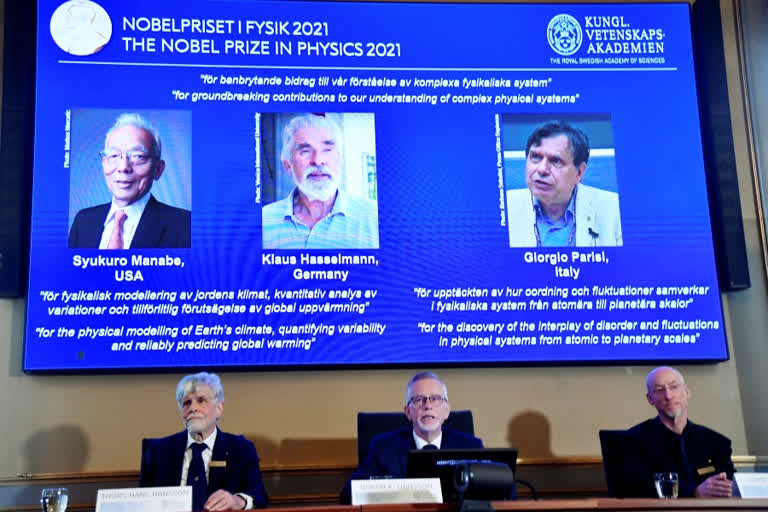Stockholm:Three scientists won the Nobel Prize in physics Tuesday for work that found order in seeming disorder, helping to explain and predict complex forces of nature, including expanding our understanding of climate change.
Syukuro Manabe, originally from Japan, and Klaus Hasselmann of Germany were cited for their work in developing forecast models of Earth's climate and "reliably predicting global warming." The second half of the prize went to Giorgio Parisi of Italy for explaining disorder in physical systems, ranging from those as small as the insides of atoms to the planet-sized.
Hasselmann told The Associated Press that he "would rather have no global warming and no Nobel Prize.'' Manabe said that figuring out the physics behind climate change was "1,000 times" easier than getting the world to do something about it. He said the intricacies of policy and society are far harder to fathom than the complexities of carbon dioxide interacting with the atmosphere, which then changes conditions in the ocean and on the land, which then alters the air again in a constant cycle.
He called climate change "a major crisis." The prize comes less than four weeks before the start of high-level climate negotiations in Glasgow, Scotland, where world leaders will be asked to ramp up their commitments to curb global warming. The Nobel-winning scientists used their moment in the limelight to urge action. "It's very urgent that we take very strong decisions and move at a very strong pace" in tackling global warming, Parisi said. He made the appeal even though his share of the prize was for work in a different area of physics.
All three scientists work on what are known as "complex systems," of which climate is just one example. But the prize went to two fields of study that are opposite in many ways, though they share the goal of making sense of what seems random and chaotic so that it can be predicted. Parisi's research largely centers around subatomic particles, predicting how they move in seemingly chaotic ways and why, and is somewhat esoteric, while the work by Manabe and Hasselmann is about large-scale global forces that shape our daily lives.
The judges said Manabe, 90, and Hasselmann, 89, "laid the foundation of our knowledge of the Earth's climate and how human actions influence it." Starting in the 1960s, Manabe, now based at Princeton University, created the first climate models that forecast what would happen as carbon dioxide built up in the atmosphere. Scientists for decades had shown that carbon dioxide traps heat, but Manabe's work offered specifics. It allowed scientists to eventually show how climate change will worsen and how fast, depending on how much carbon pollution is spewed.
Manabe is such a pioneer that other climate scientists called his 1967 paper with the late Richard Wetherald "the most influential climate paper ever," said NASA chief climate modeler Gavin Schmidt. Manabe's Princeton colleague Tom Delworth called Manabe "the Michael Jordan of climate." "Suki set the stage for today's climate science, not just the tool but also how to use it," said fellow Princeton climate scientist Gabriel Vecchi. "I can't count the times that I thought I came up with something new, and it's in one of his papers."
Manabe's models from 50 years ago "accurately predicted the warming that actually occurred in the following decades," said climate scientist Zeke Hausfather of the Breakthrough Institute. Manabe's work serves "as a warning to us all that we should take their projections of a much warmer future if we keep emitting carbon dioxide quite seriously." "I never imagined that this thing I would begin to study has such a huge consequence," Manabe said at a Princeton news conference. "I was doing it just because of my curiosity."
